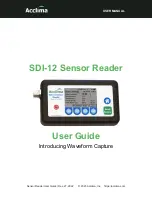
© 2022 HyQuest Solutions
17
Installation
Fit the jumper for mechanical switching at up to 20Hz. In this mode the input is normally pulled up to 12V through a 10
kΩ resistor providing a wetting current of approximately 1.2mA. A 100nF capacitor is also fitted across the input to
provide limited hardware debounce, preventing false triggering due to contact bounce.
Remove the appropriate jumper for electronic switching at up to 5kHz. In this mode the input is normally pulled up to 5V
through a 57 kΩ resistance, providing a wetting current of approximately 100mA. When DIO is used as an input the
debounce circuit is permanently connected to the input pin.
Figure 8 – Digital Input Circuit
Important note!
In almost all installations where an iRIS is connected in parallel with other equipment to share a common
pulse input (e.g. from a flow meter), there has not been a detrimental effect, as the iRIS inputs present a
relatively high impedance to the circuit. However, in the event that connecting an iRIS does cause pulse
failure, HyQuest Solutions recommend removing the debounce selection link for the appropriate input. This
sets the input to electronic switching mode, even if the actual pulse source is a clean contact (reed switch or
similar).
The debounce jumpers are located in the centre of the PCB and can be accessed once the front cover is
opened. See Figure Digital Input Debounce Links above.
Hint
: When removing a jumper, simply fit it to only one pin of the connector to avoid it being lost.
2.3.3.2
Digital Output
When the iRIS digital I/O channel is configured as an output it can be operated electrically in one of two ways. Either:
Open-drain Pull-down which is capable of sinking up to 100mA at 30Vdc. An integral diode provides transient protection.
Typically, this output mode can be used to drive a relay or lamp powered by an auxiliary DC supply (e.g. 12V). In this
mode, the negative of the load supply must be connected to one of the iRIS GND terminals.
Although it may appear possible to directly control sensors by switching the sensor negative supply lead
using a digital output, this will introduce measurement errors and may possibly damage the sensor. Always
use a digital output configured as a switched 12V output to power sensors.
Or:
Switched 12V output which is capable of sourcing up to 100mA. Typically, this output mode will be used to drive a
sensor, relay or lamp powered by the iRIS’s 12V supply.















































